drawing of blue skies rainbows green trees and blue birds
Blue and green are attention-grabbing colors associated with the sky and nature and symbolize freedom, calmness, and peace.
That's why birds that have blue and green plumage have always been very popular.
Examples of blue and green birds include the green jay, green-headed tanager, Nicobar pigeon, American purple gallinule, blue-headed parrot, and many others.
Some of these stunning birds can be seen in the USA, including the American purple gallinule and green jay, among others.
Here are their photos and some fun facts about them.
Blue And Green Birds
Green Jay
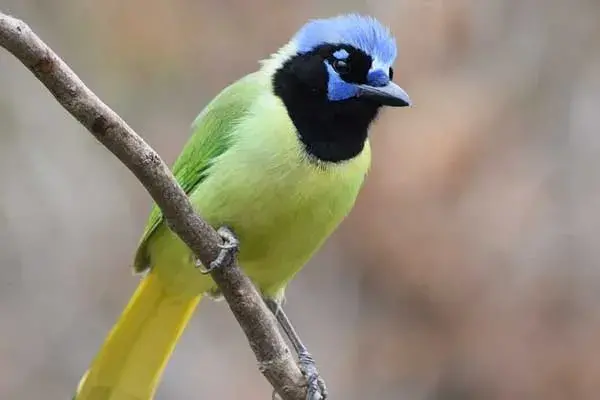
- Scientific name: Cyanocorax yncas
- Lifespan: 10-11 years
- Wingspan: 13.5-15 in
Green jays are medium-sized jays with green backs, blue and black heads, yellow underparts, and very short and blue eyebrows.
They are colorful and noisy tropical birds that are found in North, Central, and South America. In the USA, green jays can be seen year-round in Southern Texas.
They are very intelligent birds that have been seen using sticks as tools to get insects from tree bark.
Green jays are omnivores that feed on different insects, small vertebrates, seeds, and fruit.
They got their scientific name "yncas" from the word "Inca" because the first descriptions of this species were based on birds from Peru, the place where Inca Empire rose.
A group of jays is called a "band", "cast", "party", or "scold".
White-cheeked Turaco

- Scientific name: Menelikornis leucotis
- Lifespan: 10-12 years
- Wingspan: 6.9 in
White-cheeked turacos are beautiful blue and green birds found in Africa.
They are easy to identify by their green color with deep bluish tails and wings, white patches in front of their eyes, and on the side of their necks. These birds also have orange-red bills and eye rings, and blue-green crests.
White-cheeked turacos are common in tall forests, riverside forests, and wooded valleys of Eritrea, Ethiopia, South Sudan, and Sudan in Africa.
They aren't the best at flying but can run rather fast through the tree canopy.
White-cheeked turacos are omnivores and mostly feed on fruits, plants, and some insects.
Pairs are monogamous and mate for life. Both parents will take turns in incubating a clutch of 2 to 3 eggs.
At the sight of danger, they will remain still and fly away at the last second with strong wing flaps, revealing the crimson red color of their wings.
Blue-headed Parrot
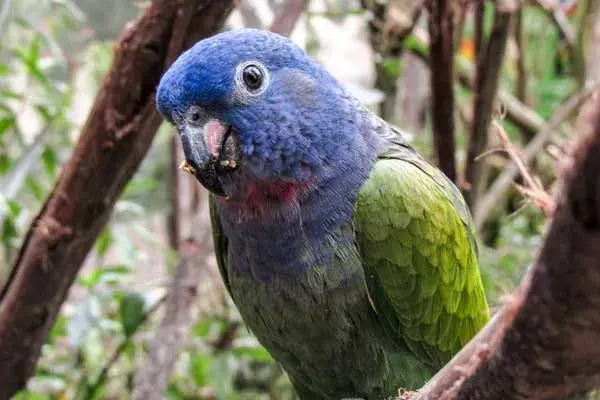
- Scientific name: Pionus menstruus
- Lifespan: 25-40 years
- Wingspan: n/a
Blue-headed parrots are medium-sized birds commonly found in forests and semi-open countries of Central and South America.
They are also known as blue-headed pionus and have the green color of their plumage and striking bright and radiant blue color of their heads.
What makes their colorful feathers unique is the bacteria-resistant pigment called Psittacofulvins that gives their feathers beautiful blue and green coloration.
These parrots are very popular pets and compared to other parrot species, they are very quiet and not famous for their ability to talk.
Blue-headed parrots are herbivores that feed on fruit and seeds, and sometimes grain.
They are cavity nesters and lay three to five white eggs per clutch that the female incubates.
Greater Blue-eared Starling

- Scientific name: Lamprotornis chalybaeus
- Lifespan: 2-3 years
- Wingspan: 15-17 in
Greater blue-eared starlings are also known as greater blue-eared glossy starlings. These birds breed in Africa and can be commonly found in open woodlands.
Greater blue-eared starlings are short-tailed birds with glossy blue and green plumage, purple-blue bellies, and blue ear patches they got named after.
Both sexes look similar and have bright yellow or orange eyes and gray-black legs and feet.
These noisy starlings are very social birds that can form huge flocks, often together with other starlings.
Greater blue-eared starlings love to nest in tree holes. The female will lay three to five greenish-blue eggs with brown-purple spots.
They are omnivores that feed on seeds, berries, and ground insects. They can be also seen on the backs of livestock, eating and cleaning them from insects and ectoparasites.
Nicobar Pigeon
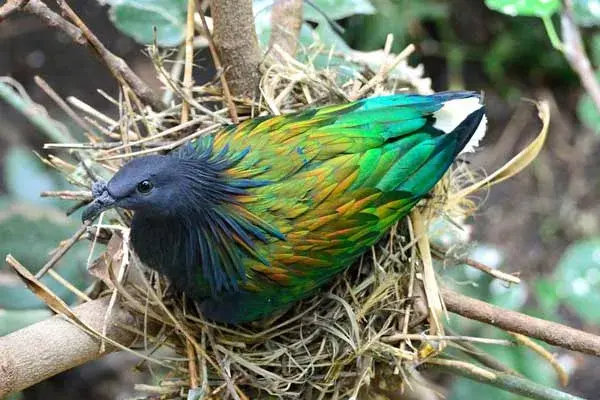
- Scientific name: Caloenas nicobarica
- Lifespan: 8-12 years
- Wingspan: 21-23 in
Nicobar pigeons are striking birds with metallic gray-blue "manes" of hairlike feathers on their heads and necks. These long hackles match perfectly with the green and blue iridescent back and complement the green, blue, and copper wings.
Native to southeast Asia, Nicobar pigeons are large birds with broad wings, short tails, and black-brown eyes.
They are omnivores that feed on hard seeds, fruits, corn, and invertebrates.
Because of their muscular gizzard (the "second" stomach a bird uses to grind food), Nicobar pigeons can digest some hard nuts that humans can only open with a hammer!
These beautiful blue and green birds are the relatives of the extinct Dodo bird.
Paradise Tanager

- Scientific name: Tangara chilensis
- Lifespan: up to 14 years
- Wingspan: n/a
Paradise tanagers are medium-sized songbirds with light green heads, sky blue underparts, and black upper plumage. Males and females look alike; the males tend to sing more often. They have black beaks and gray legs.
These multicolored songbirds are native to northern South America (Amazon rainforest).
Paradise tanagers can be often seen high in the canopy of the humid forest, often in flocks of mixed species.
They are omnivorous and feed on a range of fruits, nectar, berries, and insects.
Read More: 17+ incredible birds with green heads
Green-breasted Mango

- Scientific name: Anthracothorax prevostii
- Lifespan: 3-4 years
- Wingspan: n/a
Green-breasted mangos are hummingbirds found in Central and South America. Their scientific name "prevostii" comes from the French naturalist Florent Prévost.
Green-breasted mangos are medium-sized hummingbirds that weigh only 0.25 ounces.
Males have glossy bright green upperparts, narrow matte black throats, and chests that are bordered with blue-green.
Females are bronze-green above, white below, and have a dark central stripe on the throats. Their outer tail feathers have magenta and iridescent dark blue color.
Green-breasted mangos can be found in open habitats, including parks, forest edges, gardens, and backyards; they often visit bird feeders.
They are omnivores and feed on insects and flower nectar.
Green-breasted mangos catch insects mid-air or steal them from spider webs; this is known as kleptoparasitism.
They can be occasionally seen in the United States, thanks to rare visits of immature birds to Texas.
Green-headed Tanager
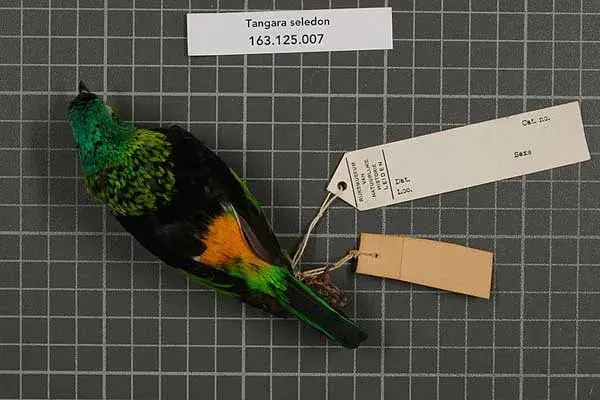
- Scientific name: Tangara seledon
- Lifespan: n/a
- Wingspan: n/a
Green-headed tanagers are brightly colored birds that breed in the humid Atlantic forests of Brazil, Paraguay, and Argentina.
They can be also found around parks and orchards where their flashy blue-green coloration camouflages them well amongst the leaves.
These small birds have bright aquamarine-green heads, napes, and chins, blue wing coverts and breasts, lime green neck patches, wings, and bellies, and orange rumps.
Females look like males but are slightly duller.
Green-headed tanagers are monogamous birds where a male might feed a female during the courtship ritual.
Both the male and the female will get involved in nest-building, egg-laying, and incubation.
Green-headed tanagers are omnivores that mainly feed on fruit, some seeds, and insects.
Blue-bellied Parrot

- Scientific name: Triclaria malachitacea
- Lifespan: up to 12 years
- Wingspan: n/a
Blue-bellied parrots, also known as purple-bellied parrots, are fairly large parrots endemic to the forests of Brazil and Argentina.
They can be identified by their relatively long tails, whitish bills, and overall green color with the blue patch on the bellies of males.
Blue-bellied parrots are commonly found in pairs or small groups in the canopy of humid forests and pairs might occasionally sing in a duet. Their call consists of a series of whistles.
They are omnivores that feed on seeds, fruits, flower nectar, and insects.
Blue-bellied parrots nest in cavities of large trees and palms and become very territorial and aggressive during the breeding season.
Blue-naped Chlorophonia

- Scientific name: Chlorophonia cyanea
- Lifespan: n/a
- Wingspan: n/a
Blue-naped chlorophonias are small, plump birds with stout beaks that live in humid forests, gardens, and parks of South America.
Males are mainly lime green with blue napes, rumps, and eye-rings. Some populations can be entirely blue above; their underparts are yellow. Females are duller and have greener bellies.
Blue-naped chlorophonias can be often seen in small flocks or pairs and heard by their whistles that consist of one to two notes.
They mostly forage in the canopy and feed on berries, leaves, nectar, and insect larvae.
Their breathtaking bright blue and green coloration provides them with great camouflage in the tree canopy.
Blue-Faced Honeyeater

- Scientific name: Entomyzon cyanotis
- Lifespan: up to 8 years
- Wingspan: 17.5 in
Blue-faced honeyeaters, also known as banana birds, are large and conspicuous birds with striking blue skin on their heads, around the eyes.
Besides blue heads, they have olive-green upperparts, white underparts, and black throats with white napes and cheeks.
Blue-faced honeyeaters are commonly found in open forests and woodlands, close to water. They are native to northern and eastern Australia and southern New Guinea.
Contrary to their name, these blue and green birds mainly feed on insects, but can be also seen eating banana fruit and flowers, hence the nickname "banana birds".
Blue-faced honeyeaters are sometimes considered pests in orchards. They can be rather noisy and aggressive, mobbing potential threats, including goshawks, rufous owls, Pacific koels, and others.
Takahe

- Scientific name: Porphyrio hochstetteri
- Lifespan: 16-18 years in the wild
- Wingspan: n/a
Takahes are the largest living rails in the world, endemic to New Zealand.
Both sexes look similar; males are slightly larger.
These stocky and powerful flightless birds have short red legs and massive red beaks.
They have dark royal blue heads, necks, and breasts, blue shoulders, and shades of iridescent turquoise and olive green on their wings and backs.
They can be also identified by their quiet hooting contact calls or muted booms.
Although flightless, takahes have wings that they use during courtship rituals or to display aggression.
Scientists considered takahes extinct before rediscovering them in 1948, deep in Fiordland's Murchison Mountains. They have a population of around 440 birds today.
Commonly found in alpine grassland habitats, these unique birds are territorial and sedentary.
They are omnivores that feed on grass, shoots, and insects. Pairs are monogamous and stay together for life.
They are also on our list of the world's largest blue birds. Check the other birds here.
Blue Dacnis
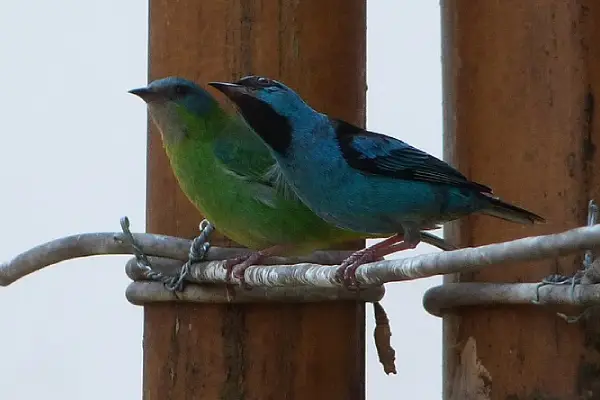
- Scientific name: Dacnis cayana
- Lifespan: up to 5 years
- Wingspan: n/a
Blue dacnis, also known as turquoise honeycreeper, is a small tanager that is common around forests, gardens, and parks of South America.
There are 8 subspecies of blue dacnis.
Females are mainly green with blue heads while the males are turquoise blue with black around the eyes, on the throats, and backs.
Blue dacnis are social birds that mainly feed on fruit and some insects they collect from foliage, flowers, or bromeliads.
They can be often heard repeating lispy "tsit" high-pitched notes.
Pacific Parrotlet

- Scientific name: Forpus coelestis
- Lifespan: 15-20 years
- Wingspan: 6 in
Pacific parrotlets are small parrots coming from tropical forests of Central and South America.
Males are green and have a blue patch behind the eyes and blue parts of the wings and the rumps. Females do not have blue parts of the wings but can have blue eye streaks and blue rumps.
Pacific parrotlets also have pinkish beaks and pinkish-gray legs and feet.
They are social birds that can gather in flocks of over 100 birds, spending hours each day in the trees where they forage for fruit and seeds.
Pacific parrotlets are popular pets that are nicknamed "pocket parrots" due to their size. They can learn to speak a few words and phrases, similar to other parrots; however, their vocabulary is relatively limited.
They are colorful, charming, and intelligent, but can become very aggressive in captivity and attack other birds when confined.
Pacific parrotlets are omnivores that feed on berries and cactus fruits in the wild; in captivity, they also consume seeds, fruit, vegetables, and herbs.
Blue-throated Barbet
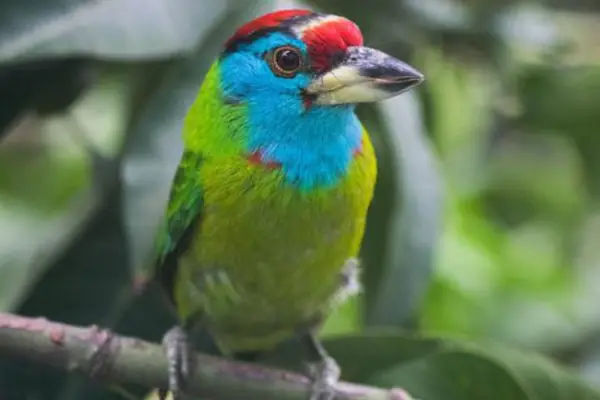
- Scientific name: Psilopogon asiaticus
- Lifespan: n/a
- Wingspan: n/a
Blue-throated barbets are medium-sized barbets that are native to Asia.
They inhabit lowland and foothill tropical forests, at elevations ranging from 660 to 6,560 ft.
Blue-throated barbets are bright green with blue throats and faces. They were named after the bristles which fringe their heavy beaks.
Blue-throated barbets are omnivores and feed on insects and fruits. They usually forage in the forest canopy but might also visit lower shrubs to feed.
American Purple Gallinule

- Scientific name: Porphyrio martinicus
- Lifespan: up to 25 years
- Wingspan: 20-24 in
Purple gallinules are medium-sized rails that breed in southeastern states of the USA.
Males are slightly larger than females and have a purple-blue color with green backs, white undertails, pale blue shields on the foreheads, and red and yellow beaks.
American purple gallinules also have long yellow legs with huge feet that help them walk on floating vegetation. They swim on the surface of the water like ducks and walk on floating vegetation like chickens.
To communicate when flying, purple gallinules will emit a cackling "kek kek kek" sound.
They are usually found alone and can be spotted around dense freshwater wetlands of the southeastern US during summer; especially around places that have a lot of water lilies, lotus, water hyacinth, and hydrilla.
These colorful blue and green waterbirds are monogamous and mate for life. They are omnivores and consume seeds, leaves, fruits, insects, spiders, frogs, snails, and fish.
Rainbow Lorikeet
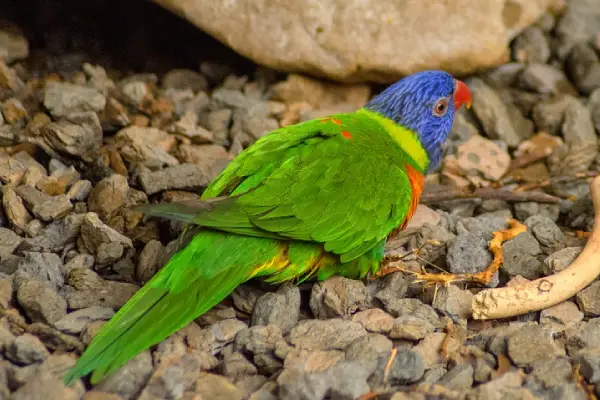
- Scientific name: Trichoglossus moluccanus
- Lifespan: 20 years
- Wingspan: 7 in
These small brightly colored parrots are found in Australia.
Rainbow lorikeets have deep blue heads and bellies, green upperparts (wings, backs, and tails), thighs, and rumps. Their chests are orange/yellow.
Adult lorikeets have orange beaks while the juvenile birds hatch with black ones.
These blue and green parrots can be seen in woodlands, rainforests, and urban areas with many trees.
They are friendly and intelligent birds with an estimated population of over 5 million.
Rainbow lorikeets are omnivores that mostly eat nectar, pollens, fruits, berries, blossoms, and buds. They might eat insects occasionally.
They make excellent pets and are very affectionate, playful, and constantly active.
Rainbow lorikeets got accidentally released in the 1960s in Australia and are now considered pests, out-competing many native birds for food.
Read More: 25 incredible orange and blue birds of the world
Blue-Tit

- Scientific name: Cyanistes caeruleus
- Lifespan: up to 10 years
- Wingspan: 7.1 in
The blue-tit is a colorful small bird found in wooded and forested habitats, parks, and gardens.
It is easily recognizable by the blue, green, and yellow plumage. Males and females look similar and have black beaks, bluish-gray legs, and dark brown eyes.
Blue-tit has an azure blue cap, white face, a dark line through the eyes, blue nape, wings, and tail, and yellowish-green back.
It is a cavity nester but might even use nest boxes. Also an omnivore, it feeds on seeds and insects.
These blue and green birds are famous for their acrobatic skills, as they can hold on to the outermost branches of trees and shrubs and hang upside down when looking for food.
There are 9 recognized subspecies today.
Indian Peafowl
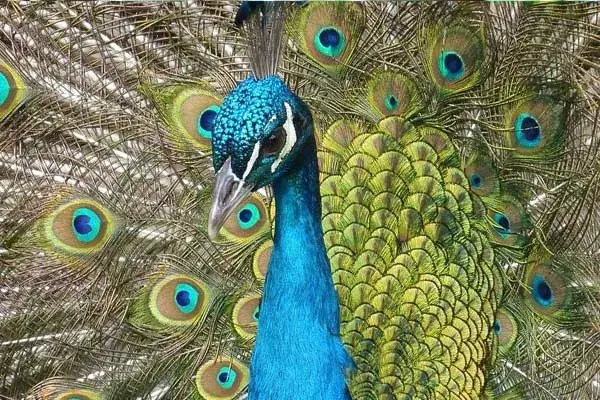
- Scientific name: Pavo cristatus
- Lifespan: 20 years
- Wingspan: 31-51 in (females); 51-63 in (males)
The Indian peafowl, also known as the common peafowl and blue peafowl, is a peafowl species native to the forests and farmlands of the Indian subcontinent.
It is a domesticated bird that has been introduced to many parts of the world.
Male peafowls are called peacocks, while the females are peahens.
Indian peafowls are brightly colored blue-green birds. Males are iridescent blue and have ornamental greenish upper tail feathers when courting females. Females have shorter tails, iridescent green necks, and browner plumage.
The Indian blue peafowl is a sacred bird and a national bird of India. It symbolizes re-growth and rejuvenation, royalty, respect, honor, and integrity.
A group of peafowl is called ostentation, or pride, which certainly fits their appearance.
Asian Green Bee-Eater
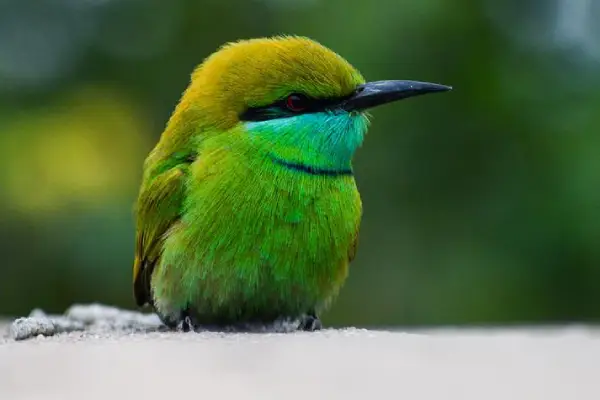
- Scientific name: Merops orientalis
- Lifespan: 12-18 years
- Wingspan: 11.6 in
Also known as little green bee-eaters, the Asian green bee-eaters are small slender birds commonly found in Asia and Africa.
They have bright green plumage with blue parts on the chins and throats, slender black face masks, and black throat bands. Their eyes are crimson, the beaks are black, and the legs are dark gray.
Asian green bee-eaters are common around open woodlands, fields, farmlands, and human habitats. They can be often seen flying gracefully and catching insects and other prey.
Asian green bee-eaters got named after their favorite type of food – bees.
They can be often seen in small groups and roost in large numbers, often exceeding 200 birds.
Want to see examples of charming green and yellow birds? Check this article.
Swallow-tailed Hummingbird
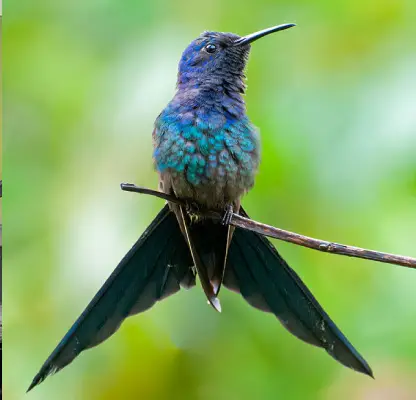
- Scientific name: Eupetomena macroura
- Lifespan: n/a
- Wingspan: 6.3-7 in
These small unmistakable blue and green birds are commonly found in open and semiopen habitats, including forest edges, plantations, and urban areas.
Swallow-tailed hummingbirds are 6.6-7 inches long, half of which is the tail, and weigh only 0.3 oz.
They can be identified by their iridescent green plumage, blue heads, upper chests, tails, and vents. They also have decurved medium-long black beaks and deeply forked dark blue tails.
Males and females look similar; females are about 25% smaller and slightly duller than males.
Depending on the hue of the plumage, there are 5 subspecies of these birds.
Swallow-tailed hummingbirds got the name for their forked swallow-like tails.
They are native to South America and feed on flower nectar and some insects.
Swallow-tailed hummingbirds are very territorial and aggressive and will even "dive-bomb" birds that are twice their size.
Emerald Toucanet
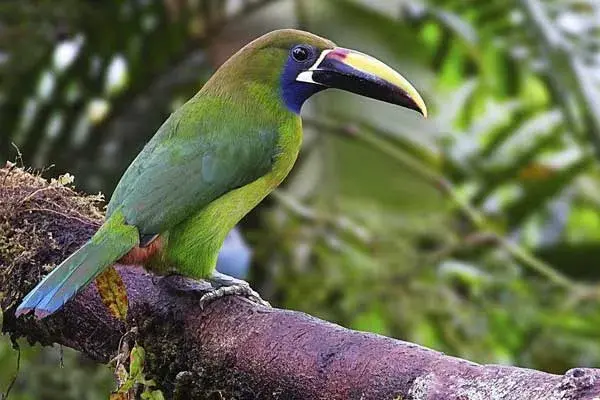
- Scientific name: Aulacorhynchus prasinus
- Lifespan: 20 years
- Wingspan: n/a
Emerald toucans are medium-sized, grass-green toucans with large beaks and blue or purplish throats.
Despite their bright plumage, these birds are excellently camouflaged – their emerald green color blends in perfectly with the forest canopy foliage.
While foraging they are known to communicate with each other through a wide variety of vocal cues.
Emerald toucanets are very active birds, covering large amounts of territory every day. They are primarily arboreal fruit-eaters, but will also take insects, lizards, and eggs.
Emerald toucanets are commonly found in pairs or small groups in mountainous regions of Mexico and Central America.
They make popular pets that can become very affectionate when hand-fed; they also love to play and interact with their owners.
White-necked Jacobin
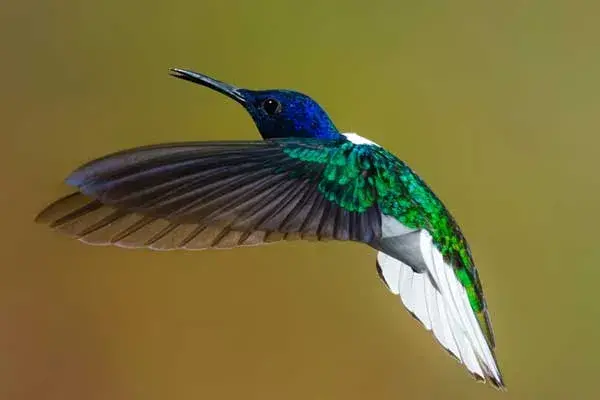
- Scientific name: Florisuga mellivora
- Lifespan: n/a
- Wingspan: n/a
These medium-sized hummingbirds have bright green upper plumage, blue heads and chests, and white abdomens and tails.
White-necked Jacobins are native to Mexico, Central, and South America.
These beautiful birds are also known as the great Jacobins and the collared hummingbirds.
They are solitary birds that only get together to breed. Males will mate with several females; females will do the same with several males.
To seduce females, males will fly in a u-shaped pattern in front of them.
White-necked Jacobins are omnivores that feed on small insects, and nectar from the flowers of tall trees, epiphytes, shrubs, and Heliconia plants.
Double-eyed Fig Parrot

- Scientific name: Cyclopsitta diophthalma
- Lifespan: 10-15 years
- Wingspan: 10.4 in
Double-eyed fig parrots, also known as blue-faced fig parrots, are tiny rainforest-dwelling parrots found in New Guinea and Australia.
With a length of just 5.5 inches and a wingspan of around 10 inches, they are the smallest parrots in Australia.
Double-eyed fig parrots are sexually dimorphic species; males are overall green with blue and red colors on their faces. Females have more subdued facial coloring and silver instead of red color on the cheeks.
They were named "fig-parrots" because they feed on fig seeds and "double-eyed" because of red patches that resemble another set of eyes.
Double-eyed fig parrots also consume berries, seeds, nectar, and some insect larvae, feeding, alone or in small groups.
Unlike other parrots that are mainly cavity nesters, double-eyed parrots will excavate their nests, usually in a rotten tree.
Read More: list of incredible Minnesota songbirds
Eclectus Parrot
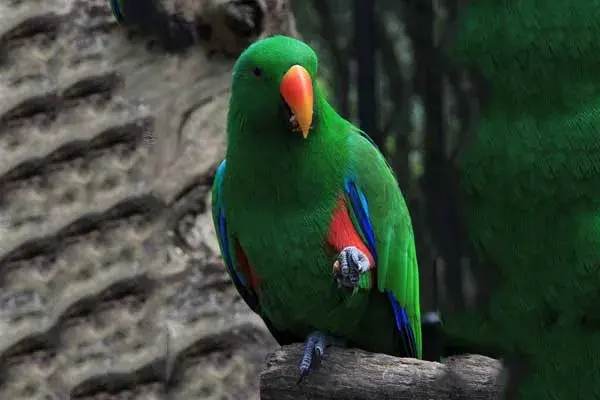
- Scientific name: Eclectus roratus
- Lifespan: 30-50 years
- Wingspan: 34-35 in
Eclectus parrots are small parrots native to the Solomon Islands, Sumba, New Guinea and nearby islands, northeastern Australia, and the Maluku Islands.
Males are generally green with blue primary feathers and red flanks, while females are red with purple abdomens.
Because of those differences, until the 20th century, people considered them to be separate species.
A healthy male Eclectus parrot will have a bright orange beak – this means that the bird is in good condition.
Eclectus parrots are shy birds that are active during the day and spend most of their time collecting food, eating, and resting.
They are great at mimicking human speech and can produce various sounds, including tones, coos, whistles, and laughs.
Want to see beautiful songbirds that live in Michigan? Check this article.
Summary
This concludes our list of blue and green birds.
Examples include several types of parrots, tanagers, pigeons, hummingbirds, and many others.
Hopefully next time you see these birds, you will recognize any of them with ease!
And if you enjoyed our article, here are other popular reads on birds: 15+ incredible green-colored birds of Florida and 25+ stunning western Washington birds
Source: https://thedailywildlife.com/blue-and-green-birds/
0 Response to "drawing of blue skies rainbows green trees and blue birds"
Post a Comment